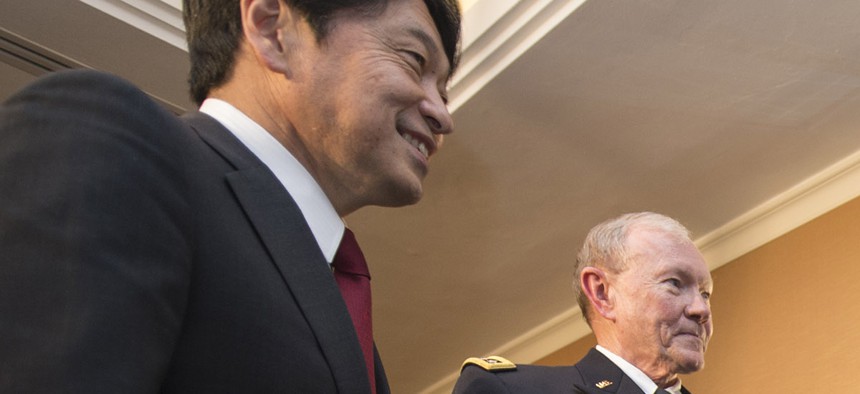
Defense Secretary Chuck Hagel and Joint Chiefs Chairman Gen. Martin Dempsey meet with Japanese Prime Minister Shinzo Abe at the Shangri La Hotel in Singapore, on May 30, 2014. DOD photo by U.S. Marine Corps Sgt. Aaron Hostutler
Turning the Asia Pivot Into a Real ‘Obama Doctrine’
Why the pivot to Asia is the wrong model for an 'Obama doctrine' and how the president can get it right. By Lawrence J. Korb
President Barack Obama’s foreign policy has been criticized for a lack of vision and a focus on “small ball”, to use his analogy. Many hoped that Obama’s commencement address at West Point would lay out a clearly envisioned doctrine that would guide our foreign policy in the post-Iraq and –Afghanistan period. Many were disappointed. While President George W. Bush laid out a doctrine of preventative war to respond to the threat of terrorism, and Dwight D. Eisenhower’s doctrine of massive retaliation laid the foundation that would shape United States’ national security strategy for years to come, a pithy Obama doctrine remains resoundingly absent.
Critics forget that three years ago, in 2011, the Obama administration did attempt to articulate such a doctrine when it rolled out the “pivot to Asia” and the accompanying “Air-Sea Battle” strategy. But, while the pivot may have been a public relations success at home, it has been increasingly clear that it is a strategic failure abroad, demonstrating how difficult it is to have a one-sized fits-all national security strategy in today’s complex world.
First, it gave the impression that we were focusing exclusively on Asia and abandoning our allies in Europe and in the Middle East, who were worried about a resurgent Russia the spread of al Qaeda offshoots and the crisis in Syria. This was not the case. We still have some 30,000 troops on the ground in Europe and the Navy’s Fifth Fleet remains in Bahrain. Rebranding the pivot as the “rebalance” to Asia did nothing to reassure these nations that the U.S. would remain a steadfast friend. Every foreign policy official, including the president, who travels to the Middle East and Europe has to constantly assure our allies that we are not abandoning them. Some in Europe and the U.S. argued that perceived American weakness in Europe is to blame for President Vladimir Putin’s aggression in Ukraine.
Second, we did not need to pivot to Asia. Even at the height of the wars in Iraq and Afghanistan, we still had between 55 and 58 percent of our naval forces in the Pacific. Increasing our Pacific naval presence to 60 percent of our forces as part of the pivot is not a seismic change. Moreover, because the size of the Navy has been declining since the pivot was announced, when the rebalance is completed in 2020, there will actually be fewer ships in the Pacific than before the pivot was unveiled. In addition, diplomatic funding for East Asia and the Pacific is less than any other region in the State Department’s annual budget. If the U.S. is pivoting to any place, it is Africa, an area that has been called the front line of the next phase of terrorist threat.
Third, Chinese leaders see the pivot and the Air-Sea Battle concept as the 21st century reprisal of our 20th century strategy of containing the Soviet Union. Every time I go to China or deal with a Chinese official, they ask repeatedly whom in Asia we intend to battle, if not them. The administration has devoted significant effort to persuading China that the pivot and Air-Sea Battle concept is not a strategy to contain China, but the Chinese remain unconvinced. After slowing down the growth of its military budget in 2010, the year before the pivot announcement, China has increased its military spending dramatically over the last three years. In 2013, it rose by 12.2 percent in real terms.
Given these concerns, the question arises of why the Obama Administration used such a poor choice of words to announce their post-Iraq and Afghanistan strategy. There are at least four reasons for their misstep:
First, given the Budget Control Act of 2011, it was clear that the gusher of defense spending that occurred after 9/11 would come to an end. The Pentagon would have to make the tough choices that they had avoided for over a decade, and they needed a framework to guide these decisions. The Pivot and Air-Sea battle were intended to provide a framework for allocating the Pentagon’s resources after the Iraq and Afghanistan wars.
Second, the announcement of the pivot was an attempt to over-correct for America’s focus on the Middle East and Afghanistan to the exclusion of other regions. Given the fact that East Asia and the Pacific account for 23 percent of the world’s population and 31 percent of its GDP, the U.S. has significant strategic interests in this part of the world.
Third, the term “Air-Sea Battle” calls back to the Nixon foreign policy strategy of containing the Soviet Union. After our withdrawal from Vietnam, the Nixon administration adopted the Guam doctrine, also called the Nixon doctrine, which proclaimed that the U.S. would no longer engage in land wars in Asia. Instead, the Pentagon would adopt a strategy called Air-Land Battle to combat the increasing military might of the Soviet Union around the globe. Branding the military portion of the pivot as the Air-Sea Battle leads one to assume that the Pentagon’s political leaders thought that Air-Sea Battle was our Air-Land Battle, Version 2.0. Even though the intent is not to contain China, the history of the term makes persuading the Chinese of this difficult.
Fourth, China was indeed increasing its military power and defense budget and becoming more assertive in the region, while the U.S. was spending trillions of dollars on unnecessary and ill-conceived wars in Iraq and Afghanistan. Therefore, with the pivot, the U.S. was trying to send a strong signal to the Chinese that “we’re back.” But this signal was not carefully calibrated and has backfired, raising China’s hackles, as Defense Secretary Chuck Hagel found out during May’s Shangri-La Dialogue conference of Asian defense ministers, in Singapore.
Could the U.S. have refocused our Asian foreign policy without such a poor choice of words? Certainly. It should have adopted a strategy of what political scientists like John Mearsheimer and Steve Walt call “off-shore balancing.” Under this approach, the U.S. would use its air and naval power to signal its commitment to the region and maintain the capacity to respond quickly to unexpected threats and events, while relying on regional powers to check one another.
In early March of this year, Assistant Secretary of Defense for Acquisitions Katrina McFarland summed it up when she said that “right now the pivot is being looked at again, because candidly it can’t happen.” Let’s hope not. And let’s be glad that Obama did not mention the pivot in his West Point speech. That will give the president another chance to get his Asia foreign policy strategy right, and avoid falling into the trap of a one-size fits all foreign policy doctrine.
Lawrence J. Korb is senior fellow at the Center for American Progress and was the Assistant Secretary of Defense for Manpower, Reserve Affairs, Installations and Logistics from 1981-1985. He has also held senior leadership positions at the Council on Foreign Relations, the American Enterprise Institute and Brookings.
NEXT STORY: It’s Time for Obama To Re-Engage with Iraq




